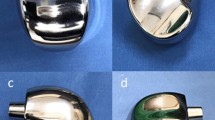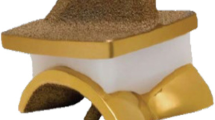Abstract
Customized talus implants have been regarded as a better treatment alternative to talus avascular necrosis than traditional surgical fusion because of its ability to maintain joint mobility while ameliorating pain. Despite the use of ankle hemiarthroplasty clinically, the cartilage contact characteristics of adjacent bones remain unclear. This study aims to use finite element modeling to evaluate the contact characteristics of three types of cobalt-chrome talus implants in three postures, in four subjects. This study also compared the contact area, contact pressure, and peak contact pressure of the implant models with a reference biological model. Among the various biological and implant models, our results showed that the biological models generally had the largest contact areas and smallest peak contact pressures, whereas the implant-type models had smaller contact areas and relatively larger peak contact pressure. Moreover, among the three implant types, customized-scale models showed a larger total contact area than that of the SSM-scale and universal-scale models, but their variation was relatively limited. The results from this study can have significance in future endeavors into ankle joint modeling, as well as being able to improve implant design to enhance recovery outcomes for patients who may benefit from talar replacement.
Graphical abstract











Similar content being viewed by others
References
Pearce DH, Mongiardi CN, Fornasier VL, Daniels TR (2005) Avascular necrosis of the talus: a pictorial essay. Radiographics 25:399–410. https://doi.org/10.1148/rg.252045709
Katsui R, Takakura Y, Taniguchi A, Tanaka Y (2019) Ceramic artificial talus as the initial treatment for comminuted talar fractures [formula: see text]. Foot Ankle Int 1071100719875723. https://doi.org/10.1177/1071100719875723
Shnol H, LaPorta GA (2018) 3D printed total talar replacement: a promising treatment option for advanced arthritis, avascular osteonecrosis, and osteomyelitis of the ankle. Clin Podiatr Med Surg 35:403–422. https://doi.org/10.1016/j.cpm.2018.06.002
Liu T, Jomha NM, Adeeb S, et al (2020) Investigation of the average shape and principal variations of the human talus bone using statistic shape model. Front BioengBiotechnol 8:. https://doi.org/10.3389/fbioe.2020.00656
Fortin PT, Balazsy JE (2001) Talus fractures: evaluation and treatment. J Am Acad Orthop Surg 9:14
Imam MA, Matthana A, Kim JW, Nabil M (2017) A 24-month follow-up of a custom-made suture-button assembly for syndesmotic injuries of the ankle. J Foot Ankle Surg 56:744–747. https://doi.org/10.1053/j.jfas.2017.02.010
Tonogai I, Hamada D, Yamasaki Y, et al (2017) Custom-made alumina ceramic total talar prosthesis for idiopathic aseptic necrosis of the talus: report of two cases. In: Case reports in orthopedics. https://www.hindawi.com/journals/crior/2017/8290804/. Accessed 26 Dec 2019
Islam K, Dobbe A, Duke K et al (2014) Three-dimensional geometric analysis of the talus for designing talar prosthetics. Proc Inst Mech Eng H 228:371–378. https://doi.org/10.1177/0954411914527741
Trovato A, El-Rich M, Adeeb S et al (2017) Geometric analysis of the talus and development of a generic talar prosthetic. Foot Ankle Surg 23:89–94. https://doi.org/10.1016/j.fas.2016.12.002
Anderson DD, Goldsworthy JK, Shivanna K et al (2006) Intra-articular contact stress distributions at the ankle throughout stance phase-patient-specific finite element analysis as a metric of degeneration propensity. Biomech Model Mechanobiol 5:82–89. https://doi.org/10.1007/s10237-006-0025-2
Kimizuka M, Kurosawa H, Fukubayashi T (1980) Load-bearing pattern of the ankle joint. Arch Orth Traum Surg 96:45–49. https://doi.org/10.1007/BF01246141
Millington S, Grabner M, Wozelka R et al (2007) A stereophotographic study of ankle joint contact area. J Orthop Res 25:1465–1473. https://doi.org/10.1002/jor.20425
Macko VW, Matthews LS, Zwirkoski P, Goldstein SA (1991) The joint-contact area of the ankle. The contribution of the posterior malleolus. J Bone Joint Surg Am 73:347–351
Brown TD, Hurlbut PT, Hale JE et al (1994) Effects of imposed hindfoot constraint on ankle contact mechanics for displaced lateral malleolar fractures. J Orthop Trauma 8:511–519
Stevens BW, Dolan CM, Anderson JG, Bukrey CD (2007) Custom talar prosthesis after open talar extrusion in a pediatric patient. Foot Ankle Int 28:933–938. https://doi.org/10.3113/FAI.2007.0933
Wagener J, Gross CE, Schweizer C, et al (2017) Custom-made total ankle arthroplasty for the salvage of major talar bone loss. Bone Joint J 99-B:231–236. https://doi.org/10.1302/0301-620X.99B2.BJJ-2016-0504.R2
Anderson DD, Tochigi Y, Rudert MJ et al (2010) Effect of implantation accuracy on ankle contact mechanics with a metallic focal resurfacing implant. J Bone Joint Surg Am 92:1490–1500. https://doi.org/10.2106/JBJS.I.00431
Reggiani B, Leardini A, Corazza F, Taylor M (2006) Finite element analysis of a total ankle replacement during the stance phase of gait. J Biomech 39:1435–1443. https://doi.org/10.1016/j.jbiomech.2005.04.010
Espinosa N, Walti M, Favre P, Snedeker JG (2010) Misalignment of total ankle components can induce high joint contact pressures. J Bone Joint Surg Am 92:1179–1187. https://doi.org/10.2106/JBJS.I.00287
Terrier A, Larrea X, Guerdat J, Crevoisier X (2014) Development and experimental validation of a finite element model of total ankle replacement. J Biomech 47:742–745. https://doi.org/10.1016/j.jbiomech.2013.12.022
Trovato AN, Bornes TD, El-Rich M et al (2018) Analysis of a generic talar prosthetic with a biological talus: a cadaver study. J Orthop 15:230–235. https://doi.org/10.1016/j.jor.2018.01.015
Liu T, Ead M, Cruz SDV et al (2022) Polycarbonate-urethane coating can significantly improve talus implant contact characteristics. J Mech Behav Biomed Mater 125:104936. https://doi.org/10.1016/j.jmbbm.2021.104936
Anderson DD, Goldsworthy JK, Li W et al (2007) Physical validation of a patient-specific contact finite element model of the ankle. J Biomech 40:1662–1669. https://doi.org/10.1016/j.jbiomech.2007.01.024
Akrami M, Qian Z, Zou Z et al (2018) Subject-specific finite element modelling of the human foot complex during walking: sensitivity analysis of material properties, boundary and loading conditions. Biomech Model Mechanobiol 17:559–576. https://doi.org/10.1007/s10237-017-0978-3
Al Jabbari YS (2014) Physico-mechanical properties and prosthodontic applications of Co-Cr dental alloys: a review of the literature. J Adv Prosthodont 6:138–145. https://doi.org/10.4047/jap.2014.6.2.138
Mondal S, Ghosh R (2019) Effects of implant orientation and implant material on tibia bone strain, implant–bone micromotion, contact pressure, and wear depth due to total ankle replacement. Proc Inst Mech Eng H 233:318–331. https://doi.org/10.1177/0954411918823811
Robinson DL, Kersh ME, Walsh NC et al (2016) Mechanical properties of normal and osteoarthritic human articular cartilage. J Mech Behav Biomed Mater 61:96–109. https://doi.org/10.1016/j.jmbbm.2016.01.015
Brown CP, Nguyen TC, Moody HR, Crawford RW, Oloyede A (2009) Assessment of common hyperelastic constitutive equations for describing normal and osteoarthritic articular cartilage. Proceedings of the Institution of Mechanical Engineers, Part H: Journal of Engineering in Medicine 223(6):643–652. https://doi.org/10.1243/09544119JEIM546
Wang CL, Cheng CK, Chen CW et al (1995) Contact areas and pressure distributions in the subtalar joint. J Biomech 28:269–279. https://doi.org/10.1016/0021-9290(94)00076-g
Wu JZ, Herzog W, Epstein M (1998) Effects of inserting a pressensor film into articular joints on the actual contact mechanics. J Biomech Eng 120:655–659. https://doi.org/10.1115/1.2834758
Fregly BJ, Sawyer WG (2003) Estimation of discretization errors in contact pressure measurements. J Biomech 36:609–613. https://doi.org/10.1016/s0021-9290(02)00436-0
Steffensmeier SJ, Saltzman CL, Berbaum KS, Brown TD (1996) Effects of medial and lateral displacement calcaneal osteotomies on tibiotalar joint contact stresses. J Orthop Res 14:980–985. https://doi.org/10.1002/jor.1100140619
Vrahas M, Fu F, Veenis B (1994) Intraarticular contact stresses with simulated ankle malunions. J Orthop Trauma 8:159–166. https://doi.org/10.1097/00005131-199404000-00014
Berkmortel C, Langohr GDG, King G, Johnson J (2020) Hemiarthroplasty implants should have very low stiffness to optimize cartilage contact stress. J Orthop Res 38:1719–1726. https://doi.org/10.1002/jor.24610
Bahr R, Pena F, Shine J et al (1998) Ligament force and joint motion in the intact ankle: a cadaveric study. Knee Surg Sports Traumatol Arthrosc 6:115–121. https://doi.org/10.1007/s001670050083
Acknowledgements
This study was funded by the Edmonton Orthopaedic Research Committee.
Author information
Authors and Affiliations
Corresponding author
Ethics declarations
Ethics approval
Ethical approval for this human study was provided by the University of Alberta Health Ethics Review Board (Pro00026057) with a waiver of individual consent.
Additional information
Publisher's note
Springer Nature remains neutral with regard to jurisdictional claims in published maps and institutional affiliations.
Rights and permissions
About this article
Cite this article
Liu, T., Jomha, N., Adeeb, S. et al. The evaluation of artificial talus implant on ankle joint contact characteristics: a finite element study based on four subjects. Med Biol Eng Comput 60, 1139–1158 (2022). https://doi.org/10.1007/s11517-022-02527-x
Received:
Accepted:
Published:
Issue Date:
DOI: https://doi.org/10.1007/s11517-022-02527-x










